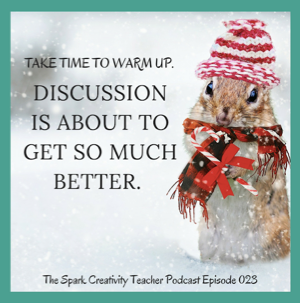Discussion Warm-Ups
Why We Need Discussion Warm-Ups
Over the years I’ve discovered my students just don’t respond well to walking into class and kicking off a discussion cold turkey.
Their heads are still all over the place, thinking about their last class, the friends they were talking to during passing, their weekend plans or their problems.
They NEVER seem to use the walk to my class to mentally review the reading. (Why is that?) So if I kick off discussion by asking a question first thing, silence and awkward eye contact avoidance is all I will get. Except of course for that one super student who always has something to say. Which really doesn’t help.
So I’m going to share with you a whole bunch of different activities and strategies you can use in the first five or ten minutes of a discussion-based class to get your students warmed up for a truly high quality discussion. In my experience, these tools make a big difference.
The other main strategy I use to create a good environment for discussion is the Harkness method. If you’re interested in learning more about that, check out my Spark Creativity Podcast Episode 008.
Warm-Up Strategy #1: Think-Pair-Share
Who doesn’t love the old “turn to your partner and….”? This is a classic teacher move, an oldie-but-goodie. I use this before discussions all the time, but I also like to use it in the middle to combat silences or give lots of students a chance to share their opinion when things are getting heated. You can always stop a discussion for another mini-warm-up or break-out session of think-pair-share.
- ask partners to write questions for the discussion
- ask partners to pick out 3 significant quotations and be ready to say why they are significant
- ask partners to take either side of a debatable topic about the text and, well, debate for a few minutes
- ask partners to discuss a question or two that you put on the board
Then, begin the discussion with an easy extension from the partner activity. No surprises needed.
Warm-Up Strategy #2: Silent Discussion
This strategy gives quieter students a voice. This is especially important for students who take longer to formulate their thoughts in English. If you work with language learners at all, this can be very helpful to them.
- put up chart paper on the walls with questions at the top, everyone circulates with a pen or marker for ten minutes responding to the questions and to others’ responses
- everyone writes a question in their notebook, then passes them to the right for the next person to respond (repeat, repeat, repeat)
- put your questions on your board or white board and ask students to write a response for at least three
- put out topic headers on the walls and give everyone sticky notes on which to contribute key quotations, questions, or comments
When you throw out the topics from the silent discussion, most students have already given them some thought and are ready to speak.
Warm-Up Strategy #3: Review Activity
Though we often want the warm-up to encourage higher level thinking, sometimes a reading has been long and complicated, or some time has passed between the reading and the discussion. In these cases, a review activity can be helpful.
- have students write one line summaries of the reading (harder than you think!) and then share them on the board
- let groups work to script and rehearse a sixty second dramatic version of the reading
- have students draft a timeline featuring the main events of the reading
- invite students to create a short graphic novel version of the reading
- let partners draft an NPR style interview with the main character
- ask students to create Sketchnotes of the main themes in the reading
This strategy gets students to think back through the reading so they are more prepared to begin on any question.
Warm-Up Strategy #4: Search & Explore the Text
Helps students incorporate citation into their discussion. This is an important thing to keep reminding them about throughout the year.
- Ask students to choose three songs they would use in a soundtrack for the reading, and be ready to quote text to explain why those songs are perfect
- Challenge students to choose the most important paragraph from the reading, and be ready to defend their choices
- Invite students to find important quotations on a certain theme or quotations to show change or development in a certain character.
Remind students as you segue into discussion that you particularly want them to focus on using their text as evidence as they discuss the reading.
Warm-Up Strategy #5: Present Something Related
This warm-up brings a more complex layer to the discussion and can help inspire critical thinking.
- share a video clip, poem, essay, or cartoon related to the reading
- bring in a guest to speak briefly on a topic related to the reading
- share a mini-lecture on a subject related to the reading
After you share something closely related to the text, have students either respond in writing or in pairs or small groups. Then kick off the discussion with a connecting question between what has been presented and the reading.
Below is a poster of 12 discussion warm-up ideas to hang by your desk. You can print this out and reference it as you get rolling with this strategy. Before you know it, you’ll be brainstorming them easily as you lesson plan.
Below are 15 printable activities that students can work on alone, in pairs, or in small groups. Each is designed to be take 10-15 minutes, and to give students a chance to review the text so they are warmed up and ready to go for whatever kind of discussion you have in mind.
